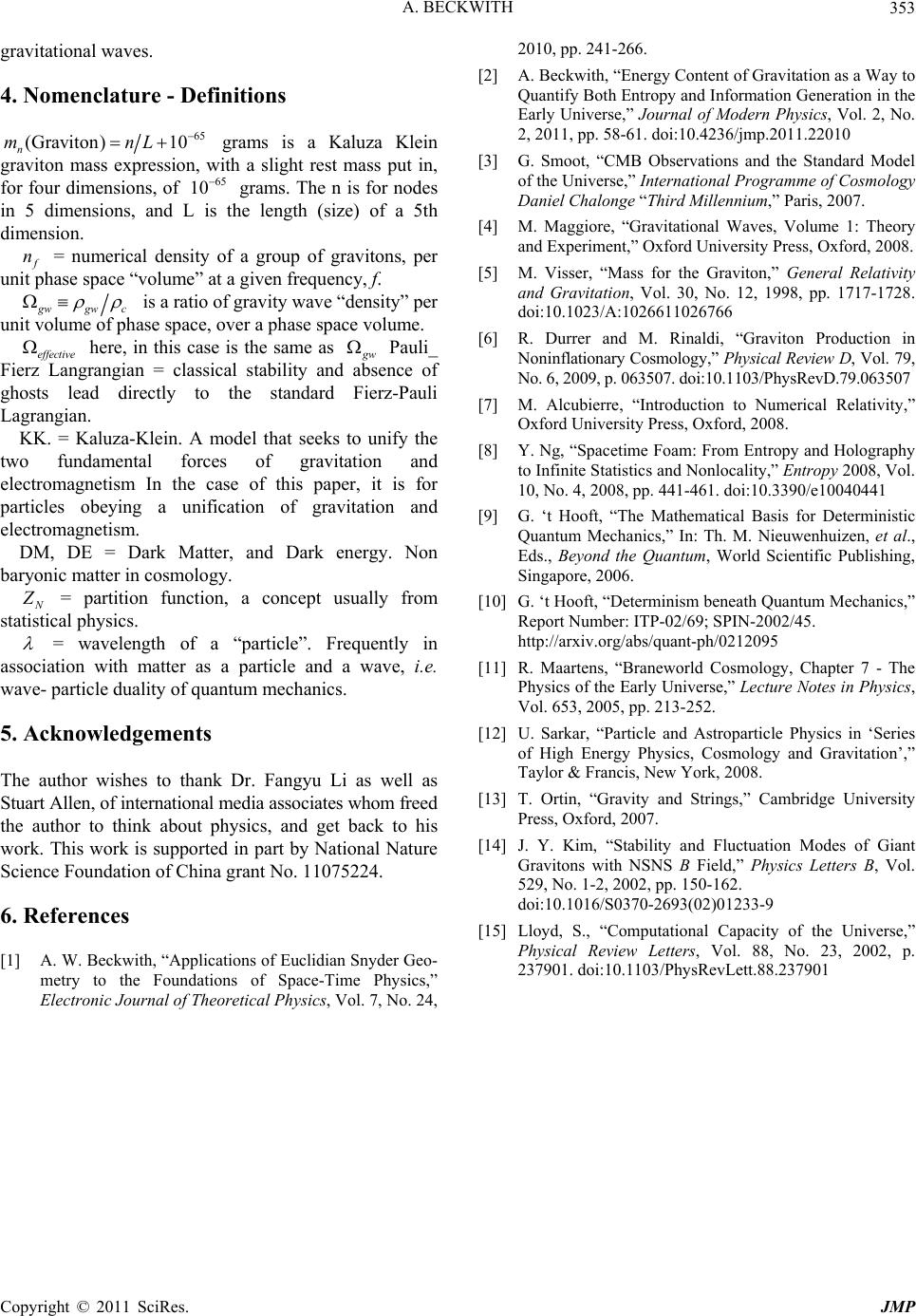
A. BECKWITH
Copyright © 2011 SciRes. JMP
353
gravitational waves.
4. Nomenclature - Definitions
65
(Graviton) 10
n
mnL
grams is a Kaluza Klein
graviton mass expression, with a slight rest mass put in,
for four dimensions, of grams. The n is for nodes
in 5 dimensions, and L is the length (size) of a 5th
dimension.
65
10
n = numerical density of a group of gravitons, per
unit phase space “volume” at a given frequency, f.
wgwc
is a ratio of gravity wave “density” per
unit volume of phase space, over a phase space volume.
effective here, in this case is the same as
w Pauli_
Fierz Langrangian = classical stability and absence of
ghosts lead directly to the standard Fierz-Pauli
Lagrangian.
KK. = Kaluza-Klein. A model that seeks to unify the
two fundamental forces of gravitation and
electromagnetism In the case of this paper, it is for
particles obeying a unification of gravitation and
electromagnetism.
DM, DE = Dark Matter, and Dark energy. Non
baryonic matter in cosmology.
= partition function, a concept usually from
statistical physics.
= wavelength of a “particle”. Frequently in
association with matter as a particle and a wave, i.e.
wave- particle duality of quantum mechanics.
5. Acknowledgements
The author wishes to thank Dr. Fangyu Li as well as
Stuart Allen, of international media associates whom freed
the author to think about physics, and get back to his
work. This work is supported in part by National Nature
Science Foundation of China grant No. 11075224.
6. References
[1] A. W. Beckwith, “Applications of Euclidian Snyder Geo-
metry to the Foundations of Space-Time Physics,”
Electronic Journal of Theoretical Physics, Vol. 7, No. 24,
2010, pp. 241-266.
[2] A. Beckwith, “Energy Content of Gravitation as a Way to
Quantify Both Entropy and Information Generation in the
Early Universe,” Journal of Modern Physics, Vol. 2, No.
2, 2011, pp. 58-61. doi:10.4236/jmp.2011.22010
[3] G. Smoot, “CMB Observations and the Standard Model
of the Universe,” International Programme of Cosmology
Daniel Chalonge “Third Millennium,” Paris, 2007.
[4] M. Maggiore, “Gravitational Waves, Volume 1: Theory
and Experiment,” Oxford University Press, Oxford, 2008.
[5] M. Visser, “Mass for the Graviton,” General Relativity
and Gravitation, Vol. 30, No. 12, 1998, pp. 1717-1728.
doi:10.1023/A:1026611026766
[6] R. Durrer and M. Rinaldi, “Graviton Production in
Noninflationary Cosmology,” Physical Review D, Vol. 79,
No. 6, 2009, p. 063507. doi:10.1103/PhysRevD.79.063507
[7] M. Alcubierre, “Introduction to Numerical Relativity,”
Oxford University Press, Oxford, 2008.
[8] Y. Ng, “Spacetime Foam: From Entropy and Holography
to Infinite Statistics and Nonlocality,” Entropy 2008, Vol.
10, No. 4, 2008, pp. 441-461. doi:10.3390/e10040441
[9] G. ‘t Hooft, “The Mathematical Basis for Deterministic
Quantum Mechanics,” In: Th. M. Nieuwenhuizen, et al.,
Eds., Beyond the Quantum, World Scientific Publishing,
Singapore, 2006.
[10] G. ‘t Hooft, “Determinism beneath Quantum Mechanics,”
Report Number: ITP-02/69; SPIN-2002/45.
http://arxiv.org/abs/quant-ph/0212095
[11] R. Maartens, “Braneworld Cosmology, Chapter 7 - The
Physics of the Early Universe,” Lecture Notes in Physics,
Vol. 653, 2005, pp. 213-252.
[12] U. Sarkar, “Particle and Astroparticle Physics in ‘Series
of High Energy Physics, Cosmology and Gravitation’,”
Taylor & Francis, New York, 2008.
[13] T. Ortin, “Gravity and Strings,” Cambridge University
Press, Oxford, 2007.
[14] J. Y. Kim, “Stability and Fluctuation Modes of Giant
Gravitons with NSNS B Field,” Physics Letters B, Vol.
529, No. 1-2, 2002, pp. 150-162.
doi:10.1016/S0370-2693(02)01233-9
[15] Lloyd, S., “Computational Capacity of the Universe,”
Physical Review Letters, Vol. 88, No. 23, 2002, p.
237901. doi:10.1103/PhysRevLett.88.237901